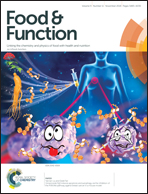Incorporation of bioactive dairy hydrolysate influences the stability and digestion behaviour of milk protein stabilised emulsions
Abstract
The physical stability of emulsions containing bioactive ingredients is an important aspect of functional food development. This research investigated the effects of a bioactive dairy hydrolysate with anti-inflammatory effects on the properties of oil-in-water emulsions (23% rapeseed oil and 1.5% w/w protein). This was determined by monitoring the effects of various combinations of sodium caseinate (NaCas) and NaCas hydrolysate (NaCasH) (NaCas : NaCasH; 100 : 0, 40 : 60, 30 : 70, 20 : 80 and 0 : 100) on the physico-chemical characteristics (particle size distribution, microstructure, adsorption of protein to the interface, viscosity and creaming stability) of emulsions. Currently, there is growing interest in designing functional foods that modulate lipid digestion. Therefore, emulsion breakdown and subsequent release of free fatty acids (FFAs) from selected NaCasH stabilised emulsions (40 : 60 and 0 : 100) was monitored during in vitro gastrointestinal digestion and compared to the behaviour of emulsions stabilised by NaCas alone. Inclusion of NaCasH generally decreased the stability of the emulsions except when added at a NaCas : NaCasH ratio of 40 : 60 which resulted in emulsions with equivalent stability to the NaCas stabilised emulsions. Although the 40 : 60 combination provided an emulsion system as stable as NaCas, during simulated digestion, these emulsions demonstrated a slower rate of FFA release. This was attributed to the 40 : 60 stabilised emulsions having much larger flocculated lipid droplets than NaCas emulsions, which resulted in reduced surface area and fewer binding sites for lipase adsorption. Accordingly, the 40 : 60 emulsions were hydrolysed more slowly. Emulsions containing only NaCasH exhibited extensive coalescence prior to and during digestion and thus displayed the slowest release of FFA. The results suggest that including NaCasH in the emulsifier blend yields emulsions with modified digestibility and may form the basis of controlling the digestion and release of fat-soluble nutrients in formulated foods. However, further studies are required to optimise the stability of these emulsions before inclusion in such applications.



 Please wait while we load your content...
Please wait while we load your content...